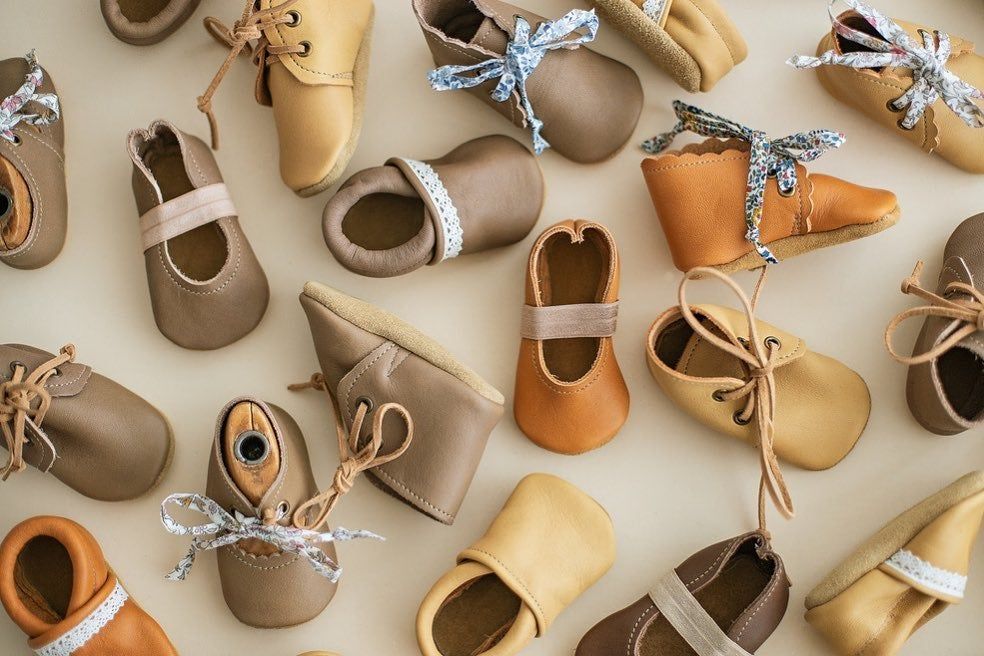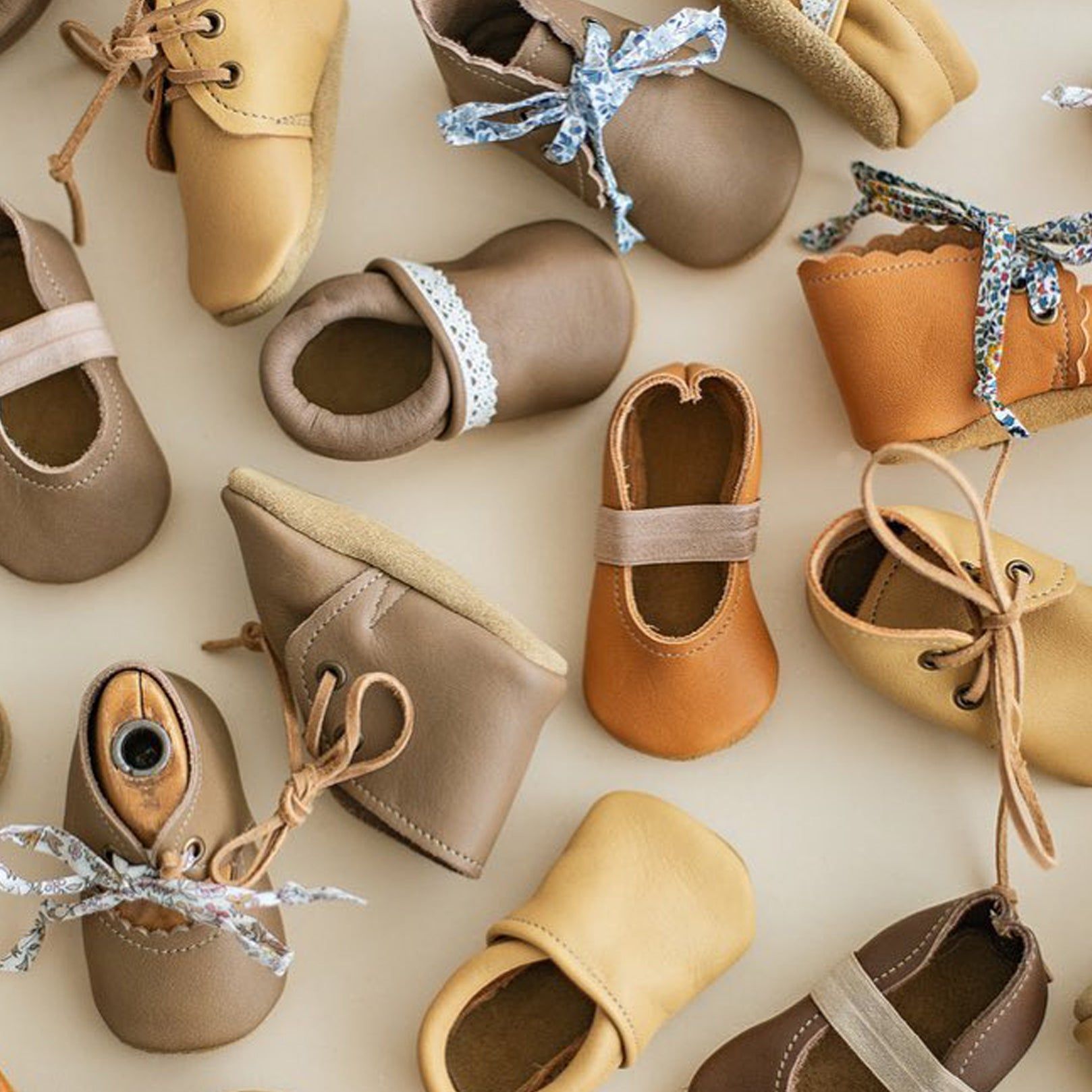
Celebrate Black Stories
Meet the Midwest Maker Behind Sun & Lace
Walk by the newest storefront on Main Street in Stoughton, Wisconsin (population 12,000). You'll likely find Briana, surrounded by leather and a child or two, handcrafting the soft, gender-neutral shoes for babies and toddlers. We caught up with her to learn about growing her family alongside her business.
- Photography
- Her Studio Co.
Have you grow up in a family of makers?
I grew up with my mom, who was crafty, and she wholeheartedly encouraged my very childish creative dreams. When I was around eight, I made a pair of shoes out of cardboard and glue. It took me all day, and then I wore them outside, and they fell apart immediately. I also had a greeting card business when I was was about six, so apparently, I must have had an entrepreneurial spirit even way back then.
When I was about ten, my mom got me my first sewing machine, and I started sewing my dolls' clothes. That grew into making my clothes in high school, and I've just always enjoyed making my clothes. And then when kids came along, I made a lot of their clothes too. I made all their coming-home outfits.
Did you always see being a maker as a possible profession?
I got my undergrad degrees in political science and Spanish at Wisconsin –what seems like a curveball now–but I thought I wanted to be an international lawyer or a CMO of a fortune 500.
And you know, I did not do anything with my degree. I moved to Chicago for nine years and got into marketing. I worked in the Merchandise Mart (a massive hub of showrooms), where I learned to prep for buyers and big wholesale shows. Eventually, I got into blogging and did that for a running app. But I was always making things at my dining room table. I even had a little Etsy shop making beaded bracelets and shirt dresses. I've always loved the challenge of learning how to make something because every time you make a new pattern, you learn a new skill. Shoes were never on my radar, but after years of using sewing to problem-solve, sewing new things is how I challenge my brain and keep it active.
Besides those cardboard shoes you made growing up, can you tell us about the first pair of shoes you made?
After leaving Chicago for Wisconsin, I wanted to make my first son some shoes since I didn't find my style in stores. I've come a long way from my first iterations. They've always had leather soles because I wanted the grip and the durability you get with leather. We live on a farm, and I wanted his feet to be protected, teetering around on our gravel driveway. The first shoes were all elastic moccasins with fabric tops. When I introduced more styles like boots around 2017, I needed leather for more structure. That tended to work better, and it was more fun to design since they kept their shape better.
How did shoemaking become a business?
I took a boot-making class in Chicago at the Chicago School of Shoemaking (where they have classes aptly called Boot Camp) to learn the basics of boot structure and fit. I was fortunate that I didn't need to get a 9 to 5. I wanted to be home, but also doing something creative, set my hours–back. Then I thought I was busy, but now I have three kids instead of one, and I know differently! I started with a studio above my garage, so my son would come hang out. I have a little corner up there with thread that he'd play with or I'd work when he was napping. I had a second child in 2016 and then my third child in 2019. I bought all the supplies to make adult shoes, and then I didn't because I became busy with another baby! So I had less and less time so I had to be smarter about how I spend my day and grow Sun & Lace.
How do you make decisions about growing the business while also growing your family?
Moving my studio out of the house was such a good thing to do mentally because then I could separate work and business. And thankfully, we have fantastic childcare now; I obviously could not work as much outside of the house without that. I have a double set up–one at my studio and space upstairs in my house so I can work where I need to at any given time.
I love having that space to grow the business bigger than me. One of my seamstresses works from home, and then I have an assistant who is still in school, so she works my shop on the weekends and then comes in at night during the week and does some cutting for me.
To give you an idea of my day's schedule, I drop my oldest two off at 7:30 am. Then, I went to my studio with my two-year-old, and we hung out there until about it's time to pick up my middle one in 4K around 11 am.




I think people feel like they need to be in a big city like New York, Chicago, or LA to launch a successful business. But has Wisconsin allowed you to have space and a setup that you couldn't replicate in a bigger city?
Coming from a condo in Chicago, we wanted space when we moved to Wisconsin, and now we have about 15 acres, and we had a spare room where I could start my business, whereas, in Chicago, there was no space to work or store anything in our condo. We live in a small town in Wisconsin, and our main street had a few empty storefronts when I needed more studio space, and I asked myself, "Why not open a storefront?"
My building is so pretty; the owners renovated it before I got in; it was built in the 1860s. It's enormous with the original floors, exposed brick, and a tin ceiling. It looks beautiful inside, and I thought, "I need this." It's worked out so well. I have it set up with games, LEGOs, and floor cushions for when my kids are here.
Have you found like-minded small makers, or is there a community of small business owners?
When I first moved to our area, I was part of a bigger makers group, and one of those makers opened a store down the road, which was the first store that sold my shoes.
Our town is really small (12,000 people) and our Main Street is two blocks long, and there were a lot of empty storefronts. There were three of us to open the same type of storefront upfront and studio space in the back around the same time. We all have very different concepts, but it's been nice getting to know them.
I have movable walls in my studio that are half walls that my sewing machine sits right behind so people on the main street can see my leathers and all my tools, cutting machines, and everything. It's the coolest thing. People can see everything made here with those machines; we do it all right here. And the local people think it's awesome.
What does success look like for Sun & Lace–where do you go next?
As a business, you have to focus on growth. My assistant is also very crafty, and it's been fun teaching her the ropes. She might want to do crafts one day as a business, so I'm teaching her about running a craft business too.
I just moved into my space in November, but I want to grow our community by hosting local events and my local customers. For example, I want them to be able to customize and design their own shoe or bags. I want to be able to give back; I've been asked to be on some local committees in town and to speak on diversity and inclusion. I am the second Black-owned shop, and I'm the first to have a storefront on our Main Street.
We are talking about stories that like made a significant impact on our lives, those stories we want to pass on to our kids. Were there family stories of makers that made an impression on you?
My mom made the biggest impact on me; she is the greatest. I have memories of her teaching me how to embroider. I eventually want to incorporate embroidery into my designs. She passed away about fourteen years ago, but I feel like she'd be really proud of me. I'm definitely an independent woman, and I get it from her. And I think my daughter is totally getting her independent spirit too. I think I still have the sewing machine that she got me. I made my daughter's baptism shoes out of my mom's favorite church dress from the nineties, with an oversized floral print. I put them in a glass box, and they're on my desk in my office.
I saw that you teamed up with @alohakaala, on a poem as part of recent collaboration. Have you always thought about your shoes in this poetic sense?
Her words just inspired me so much. I've never been inspired by poetry, but her words are just so pretty. She gave me a few different phrases, and we ended up with "Joy in the Journey," for our collection and she wrote a longer poem that's just beautiful.
I've made thousands of shoes and shipped them out worldwide, but when people take the time to tell me what the shoes that I've made mean to them in their family, it's so humbling. They've been a part of baptisms, birthday parties, and they traveled across the world. I've made some special orders for people grieving. I enjoy having the little shoes that I make be like a little part of peoples' lives because while they are just a little part, but it's an important part.
What motivates you to keep building Sun & Lace?
Having my kids see me do this work keeps me going. My daughter is two, and she likes to press the pedal on my machine and being a foot model–she'll try to squeeze on a shoe like in Cinderella. My oldest is so proud of me and tells everyone I'm the only Sun & Lace in the world.
At some point, we lost the makers' spirit and joy in making crafts, so it's essential to remember to value stepping away from technology and making things with our hands. I like teaching my kids about hard work.
When they were younger, they visited me in my studio upstairs, and now I have this big space downtown where they spend time and do things like help decorate my storefront windows. It feels like a real mom and pop from older generations and makes me nostalgic that our generation is doing this again, revisiting making.
Shop Sun & Lace
Image credits: Baby girl: Her Studio Co., Studio shot: Beth Skogen Photography, Shoes: H. Claire Photography